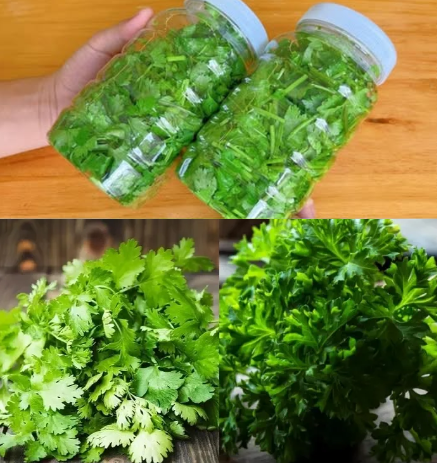
Let’s be honest—cilantro is a game-changer in the kitchen. Whether you’re whipping up salsa, garnishing soup, or tossing it into a curry, its bright, citrusy kick brings dishes to life. But there’s just one problem… it wilts faster than your willpower on a cheat day. You buy a bunch, use a sprig, and days later, it’s a sad, slimy mess in the fridge.
Good news? You don’t have to toss it. With the right techniques, you can store cilantro for months and keep its flavor, color, and aroma intact. Below are four tried-and-true methods that’ll make sure this amazing herb is always ready when you are.
Why Preserve Cilantro in the First Place?
Before we dive into the how, let’s talk why. Cilantro is rich in vitamins A, C, and K, plus it offers detoxifying properties and supports digestion. And let’s not forget—fresh herbs can get pricey, especially if you’re tossing them weekly.
By learning to preserve cilantro, you’re not just saving flavor, you’re also saving money, reducing waste, and making weeknight dinners way more flavorful with minimal effort.
1. Freeze Cilantro in Olive Oil (Best for Cooking)
If you’re looking for the easiest way to lock in flavor without sacrificing freshness, freezing cilantro in oil is a total game-changer. It’s perfect for cooked dishes where you want that unmistakable herbaceous note.
How to Do It:
- Wash the cilantro thoroughly and dry it well. A salad spinner or paper towel does the trick.
- Chop the leaves and soft stems finely.
- Spoon about 1–2 tablespoons into each slot of an ice cube tray.
- Cover with olive oil (you can also use avocado oil).
- Freeze until solid, then pop the cubes into a freezer-safe zip bag.
When to Use It:
Add these frozen cubes to soups, stews, stir-fries, marinades, or rice dishes. As the oil melts, the cilantro flavor infuses into the dish beautifully.
2. Make a Cilantro Paste (Perfect for Sauces and Marinades)
If you’re all about sauces, dressings, or marinades, this method is your best friend. Think of it as your secret green weapon for adding an instant punch of flavor.
How to Do It:
- Toss washed cilantro into a blender or food processor.
- Add a bit of olive oil or water—just enough to blend smoothly.
- For extra zing, toss in garlic, chili, or lime juice.
- Blend until you get a vibrant green paste.
- Pour into ice cube trays or small airtight containers, then freeze.
When to Use It:
Blend into salsas, chutneys, salad dressings, or smear it on grilled meats. It’s like cilantro on steroids—bold, vibrant, and ready when you are.
Video : 3 Ways to Preserve Cilantro for Weeks or Months! CiCi Li – Asian Home Cooking Recipes
3. Dry Cilantro for Garnishing or Herbal Tea
Let’s be real: drying cilantro won’t give you the same flavor burst as fresh or frozen. But it’s still totally worth doing—especially if you want to use it in soups, spice blends, or even detox teas.
How to Do It:
- Tie cilantro stems into small bunches.
- Hang them upside down in a dry, airy space, away from direct sunlight.
- After 7–10 days, the leaves will be dry and crisp.
- Crumble them gently and store in a glass jar or sealed container in a cool, dark place.
Pro Tip:
The dried version works great when sprinkled over broths or blended with other dried herbs. It’s subtle but adds depth.
4. Freeze Whole Cilantro Leaves (Super Simple Method)
Short on time? No problem. Freezing cilantro leaves directly is the fastest and least messy way to preserve them.
How to Do It:
- Wash and thoroughly dry the cilantro.
- Spread the leaves in a single layer on a baking tray.
- Freeze until solid—usually takes a couple of hours.
- Transfer to a zip-top freezer bag and store.
When to Use It:
Toss frozen cilantro directly into hot dishes. The flavor stays bold and bright, though the texture may soften (not ideal for raw garnishing, but great in anything cooked).
Avoid This Common Mistake: Fridge Storage Gone Wrong
Let’s talk about what not to do.
Stashing fresh cilantro in a plastic produce bag in the fridge is basically a countdown to disappointment. Within days, it’ll turn slimy or wilt. Storing it wet? Even worse.
If you must store it in the fridge short-term, place the stems in a glass of water (like a bouquet), cover loosely with a bag, and change the water every couple of days. But for long-term storage, freezing or drying is the only way to go.
Which Method Should You Choose?
Here’s a quick breakdown to help you decide:
| Method | Best For | Flavor Retention | Effort Level |
|---|---|---|---|
| Olive Oil Cubes | Soups, stir-fries, hot dishes | High | Low |
| Cilantro Paste | Sauces, dressings, marinades | High | Medium |
| Dried Leaves | Tea, broths, garnishing | Medium-Low | Low |
| Whole Leaf Freezing | Quick-add to cooked meals | High | Super Low |
Pick what works for your cooking style—or try a mix of methods so you’ve always got cilantro in a form that fits your needs.
Video : How to Preserve Cilantro (Stays Good for 5 Months)
Conclusion: Keep Cilantro Fresh, Flavorful, and Ready Anytime
Cilantro may be delicate, but with the right storage strategy, it doesn’t have to be short-lived. Whether you freeze it in olive oil, blend it into a bold paste, dry it for soups, or toss whole leaves into the freezer—you’ll save money, reduce waste, and always have that fresh herb flavor at your fingertips.
No more tossing wilted bunches. No more running to the store mid-recipe. Just bright, zesty cilantro—on demand. 🌿


